Customized Employee Reward Strategies for Motivation
Enhance employee motivation with a customized staff rewards strategy. Discover monetary incentives, social recognition, and points-based systems. Start rewarding now!
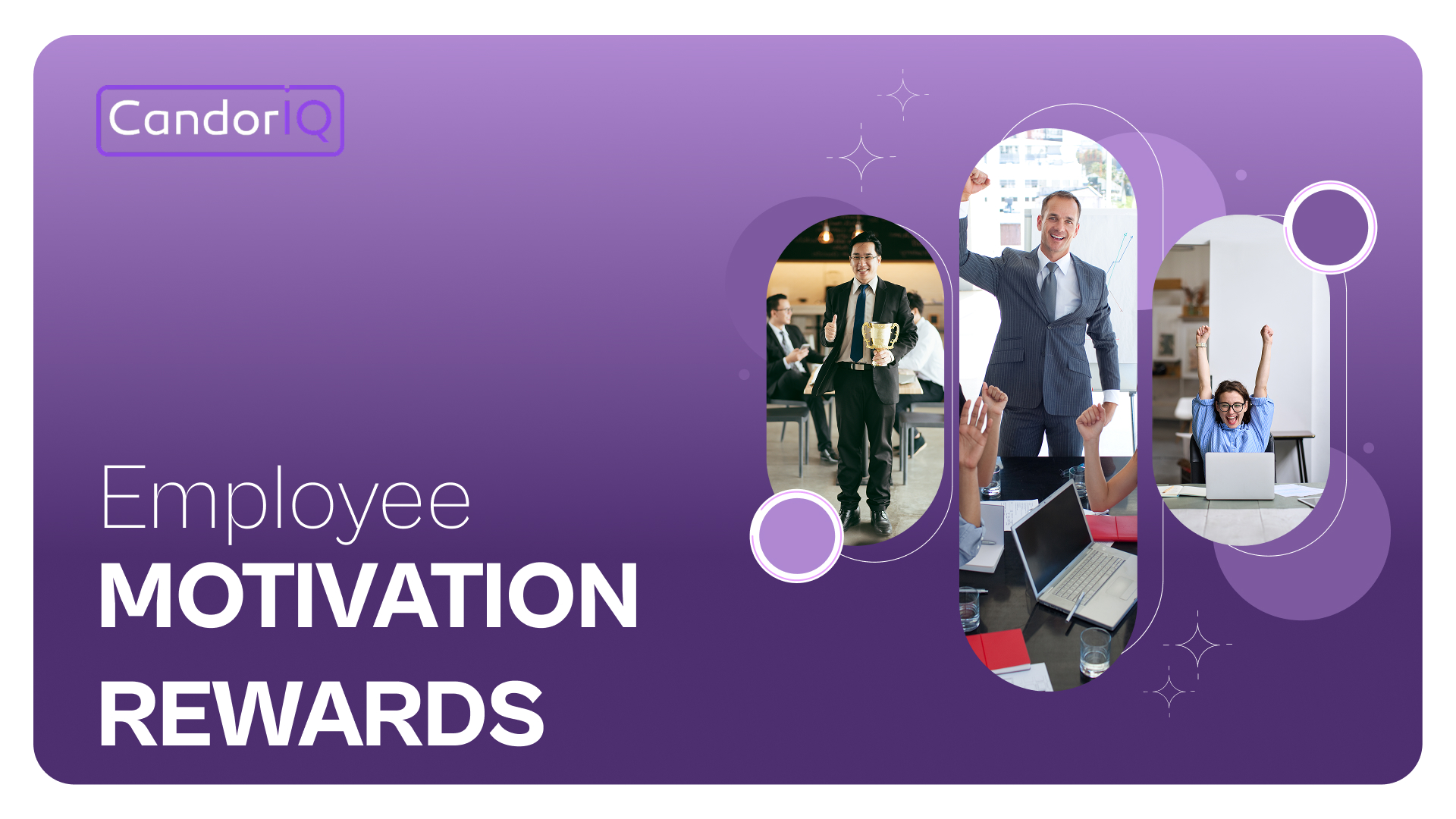
Most employee reward programs fail, not due to lack of intent, but because they rely on generic perks that don’t resonate. In a hybrid, multigenerational workforce, generic incentives don’t motivate or retain top talent. A customized staff rewards strategy is your competitive edge, because when rewards are tailored to individual roles, milestones, and motivations, they drive real engagement, loyalty, and performance.
We understand how frustrating it can be to invest time and resources into reward programs that just don’t connect with your diverse teams or fail to produce lasting motivation.
In this article, you’ll explore how to design, implement, and measure personalized reward strategies that align with your business goals, and how tools like CandorIQ make it easier to scale recognition without sacrificing equity or impact.
TL;DR:
- Customized rewards outperform generic perks by aligning with individual motivators, roles, and milestones.
- Personalized recognition boosts engagement, retention, and performance across diverse, hybrid teams.
- Effective reward strategies require segmentation, performance triggers, automation, and budget control.
- CandorIQ integrates rewards with compensation and HRIS, enabling scalable, fair, and data-backed recognition.
- Measuring impact through engagement, retention, equity, and ROI is essential for continuous improvement.
Why Customization Matters in Reward Strategies
A customized staff rewards strategy is a business imperative. As workplace expectations shift and employee diversity increases, cookie-cutter incentives lose their effectiveness. Personalization turns recognition from a transaction into a meaningful driver of performance, retention, and culture.
The Problem with Generic Rewards
Generic rewards, gift cards, plaques, or blanket bonuses, may check the recognition box, but they rarely inspire lasting impact. They fail to consider:
- Individual motivators: What energizes a software engineer may not appeal to a sales executive.
- Cultural differences: Global teams value rewards differently based on regional and generational norms.
- Career stage relevance: Early-career professionals may prioritize learning opportunities; senior leaders may seek equity or legacy-building perks.
What Customization Unlocks
When you tailor recognition and rewards, you create value that aligns with your people and your business goals. Here’s how:
1. Increased Employee Engagement
Customized rewards improve how valued employees feel and it shows in performance. According to Gallup, highly engaged employees achieve 14% higher productivity.
2. Retention and Loyalty Gains
When employees receive recognition that reflects their contributions and preferences, they're more likely to stay.
3. Alignment with Company Values and Goals
A personalized rewards system allows you to reinforce what matters most, whether it’s innovation, collaboration, or leadership development. For example, rewarding cross-functional impact with learning stipends reinforces a culture of growth.
Recognizing quota-overachievement with equity options aligns short-term effort with long-term ownership.

Why It Matters to You
As a business leader, you need your rewards strategy to serve more than HR goals, it must support:
- Scalable performance management: Tie rewards to KPIs that drive growth.
- Equitable recognition at scale: Ensure consistency without sacrificing personalization.
- Budget accountability: Deploy rewards with measurable ROI.
Core Components of a Customized Staff Rewards Strategy
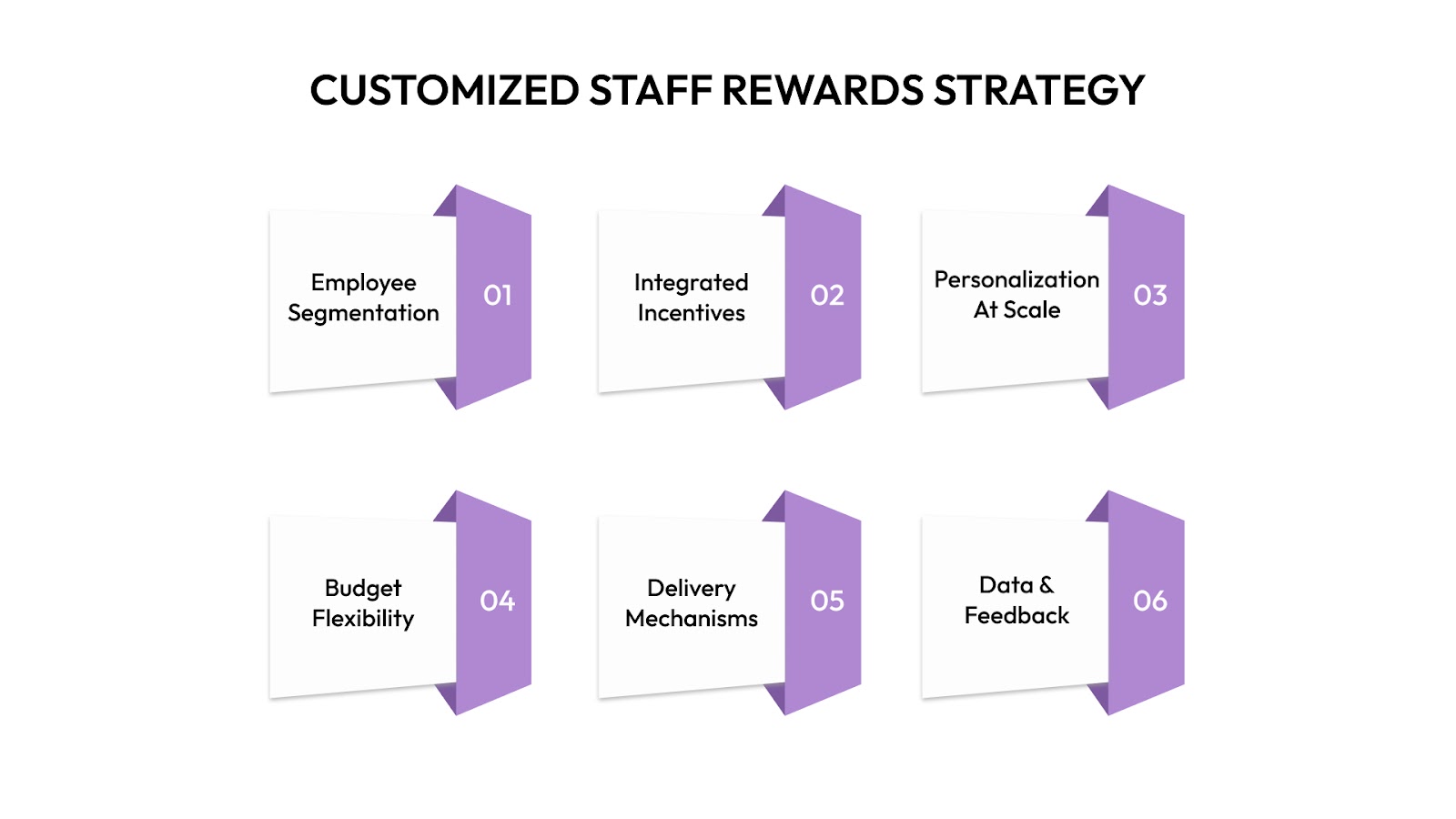
A customized staff rewards strategy isn’t about perks for the sake of perks, it’s about structured, data-informed recognition that reflects your workforce’s diverse motivations while reinforcing your company’s goals.
To make it work, you need more than good intentions. You need a system built on the following core components:
1. Segmentation by Persona or Employee Type
Not all employees value the same things. Segmenting your workforce allows you to offer rewards that are relevant and impactful.
Segment by:
- Role (e.g., sales vs. engineering)
- Location (remote, in-office, or global teams)
- Tenure or career stage
- Behavioral attributes (recognition preferences, achievement style)
2. Integrated Performance-Based Triggers
To avoid favoritism or ad-hoc recognition, tie rewards to clear performance indicators.
Examples include:
- Project completion milestones
- Revenue targets
- Peer-nominated collaboration awards
- Upskilling achievements or certifications
3. Personalization at Scale
Customization doesn't mean manual. Use data to automate and scale personalized recognition without losing relevance.
Consider tools that allow you to:
- Send birthday or milestone rewards based on employee records
- Offer a curated catalog of reward options (charity donations, learning credits, time off, etc.)
- Personalize messages based on recent contributions or achievements
CandorIQ helps personalize rewards by integrating with compensation data, ensuring alignment with role, level, and performance thresholds.
4. Budget Governance and Flexibility
You need a system that balances autonomy with fiscal discipline.
Set controls like:
- Reward limits per department or team
- Manager-level approval workflows
- Visibility into total reward spend versus impact
5. Multi-Channel Delivery Mechanisms
Recognition should meet your employees where they are, digitally, in meetings, or through their managers.
Your strategy should support:
- In-chatbot nudges (e.g., via tools like Slack, Teams, or CandorIQ integrations)
- Manager-led in-person or virtual recognition
- Email or platform-based announcements
- Integration into performance reviews or quarterly check-ins
6. Data and Feedback Loops
Rewarding without measurement leads to missed opportunities. You need to know what’s working, and what isn’t.
Track:
- Redemption rates by reward type
- Employee satisfaction post-recognition (CSAT)
- Impact on retention and internal mobility
- Manager participation rates
Platforms like CandorIQ let you monitor reward effectiveness alongside compensation fairness, promotion velocity, and attrition signals, all in one dashboard.
Building a customized staff rewards strategy requires thoughtful orchestration. But with the right components, rooted in segmentation, automation, and governance, you can deliver meaningful, scalable recognition that supports your people and your bottom line.
Popular Custom Reward Categories That Drive Motivation
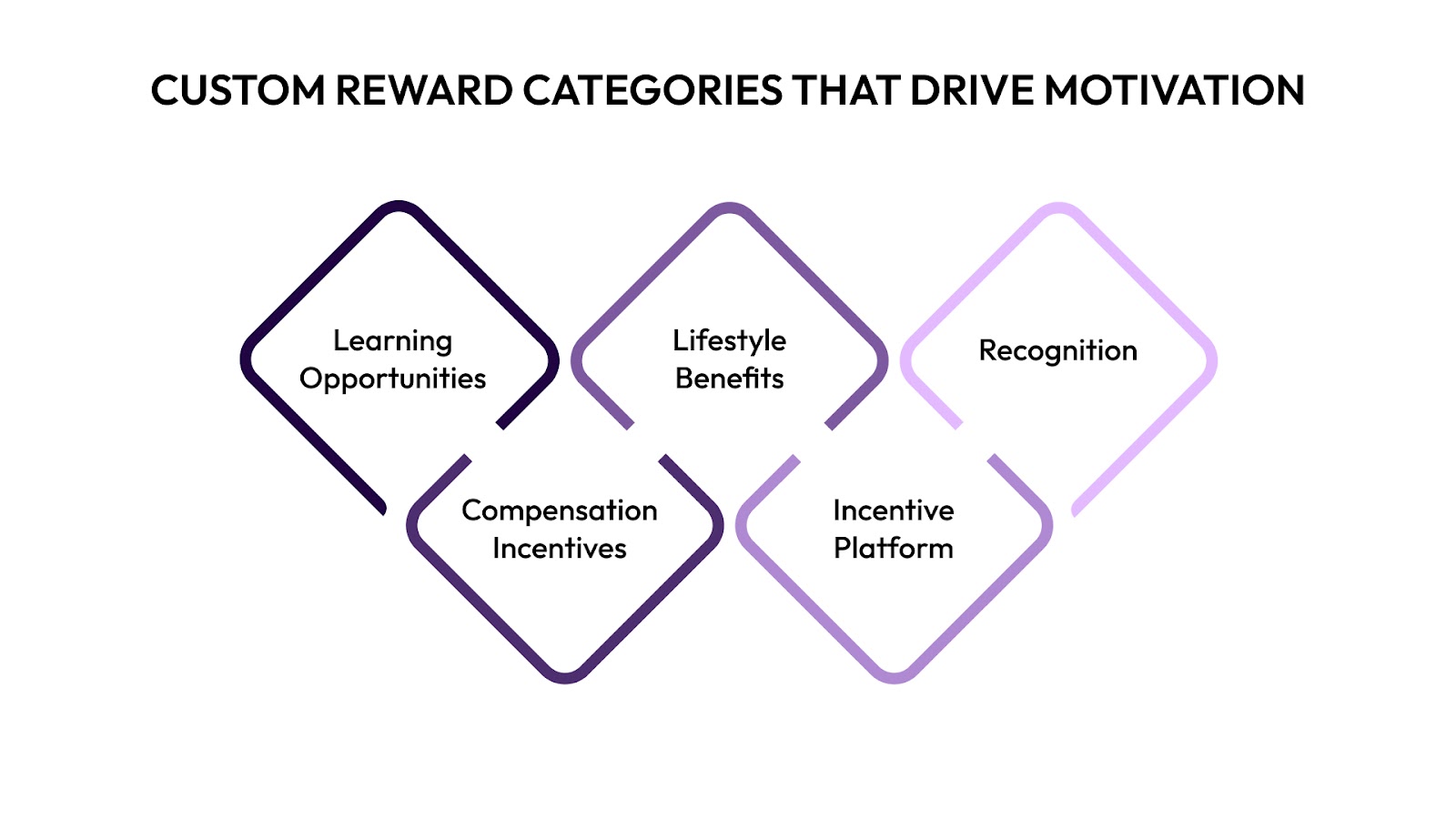
An effective customized staff rewards strategy goes beyond generic gift cards or team lunches. To truly drive motivation, rewards must reflect what your employees value, professionally, personally, and emotionally.
Here’s a breakdown of the most impactful reward categories used by high-performing organizations, along with actionable insight on how to deploy them effectively.
1. Career Growth & Learning Opportunities
Employees who feel invested are more likely to stay. According to LinkedIn’s 2024 Workforce Learning Report, 94% of employees said they would stay at a company longer if it invested in their learning.
Top rewards in this category:
- Sponsored certifications or industry training
- Access to premium learning platforms (e.g., Coursera, MasterClass)
- Paid attendance to conferences or seminars
- Dedicated learning stipends for self-paced development
CandorIQ integrates performance and compensation data to trigger growth rewards when employees hit upskilling milestones.
2. Wellness and Lifestyle Benefits
Wellness rewards signal that you see your employees as whole individuals—not just workers.
Popular options include:
- Mental health app subscriptions (e.g., Calm, Headspace)
- Gym or wellness reimbursements
- Healthy meal kits or grocery gift cards
- Extra personal days for mental wellness
3. Recognition and Experience-Based Rewards
Personalized experiences create emotional connection and lasting memories, both of which amplify motivation.
High-impact choices:
- Team celebration experiences (virtual or in-person)
- Personalized thank-you videos from leadership
- VIP event access (concerts, shows, etc.)
- Curated travel or staycation vouchers
4. Financial and Compensation-Based Incentives
While not the only motivator, financial recognition remains one of the strongest drivers of performance when used strategically.
Best practices include:
- Spot bonuses for project completion or peer nominations
- Performance-based equity awards
- Pay band transparency and merit raise previews via tools like CandorIQ
- Charitable donation matching in employees' names
5. Choice-Based Reward Marketplaces
Sometimes the best reward is the freedom to choose. Empowering employees with flexible reward options improves satisfaction and eliminates generic misfires.
Offer through:
- Digital reward catalogs segmented by team or budget
- Point-based systems to accumulate and redeem on-demand
- Flexible benefit wallets (customizable by lifestyle preferences)
Incentivizing your workforce isn’t about spending more, it’s about rewarding smarter. When you align your customized staff rewards strategy with employee preferences and business goals, you create a high-performance culture fueled by relevance and recognition.
Want to take the guesswork out of reward alignment? With CandorIQ, you can connect compensation data, performance insights, and reward automation, all in one place.
How to Design a Rewards Program That Works

Designing a customized staff rewards strategy that actually drives performance and retention isn’t about handing out perks at random. It’s a deliberate process that aligns your recognition system with business goals, workforce data, and individual motivation drivers.
Here’s a step-by-step framework to help you build a high-impact rewards program that scales with your organization’s needs.
1. Start with Strategic Alignment
Your rewards program must support broader business and talent goals.
Key questions to ask:
- Are you trying to reduce attrition, boost engagement, or accelerate performance?
- Which teams or roles are underrecognized but critical to your strategy?
- How does this program complement your compensation, DEI, and performance planning initiatives?
2. Segment Your Workforce by Persona
What motivates your sales team won’t necessarily engage your product managers.
Segment by:
- Function (e.g., sales, engineering, operations)
- Tenure or career stage
- Work location (remote, hybrid, in-office)
- Recognition preferences (monetary vs. experiential vs. development-driven)
3. Tie Rewards to Performance and Milestones
Recognition only works when it’s timely, fair, and linked to measurable outcomes.
Build triggers around:
- Quarterly OKRs or performance review outcomes
- Promotion or tenure milestones
- Manager or peer-nominated achievements
- Cross-functional contributions or innovation initiatives
4. Involve Managers and Peers
Leadership-driven programs lose momentum without buy-in at the team level.
Best practices:
- Empower managers with discretionary reward budgets
- Introduce peer-nomination workflows for collaborative impact
- Train managers to recognize effort—not just results
5. Ensure Flexibility and Choice
Rigid reward programs quickly lose relevance. Build flexibility into your model.
Offer:
- A catalog of rewards aligned to different personas
- Opt-in benefits (learning stipends, wellness perks)
- Quarterly or semi-annual refreshes to keep offerings fresh
6. Track ROI and Engagement
You can't improve what you don't measure. Use data to optimize your rewards program continuously.
Metrics to track:
- Participation rate by department or level
- Reward redemption and satisfaction scores
- Correlation between rewards and retention/performance
- Sentiment and engagement changes post-reward cycles
CandorIQ dashboards let you connect recognition activity with workforce trends, attrition risk, and compensation effectiveness in real-time.
The difference between a feel-good rewards initiative and a strategic retention tool is execution. A well-designed, data-informed, and contextually relevant customized staff rewards strategy turns recognition into a business driver.
With CandorIQ, you can connect performance, compensation, and rewards into a single, scalable ecosystem, enabling smarter decisions and more meaningful employee experiences.
Linking Customized Rewards to HRIS and Compensation Systems
A customized staff rewards strategy delivers maximum impact only when it’s connected to the rest of your HR infrastructure. Treating rewards as a siloed initiative limits its strategic potential. By integrating your rewards program with your HRIS and compensation systems, you ensure consistency, transparency, and scalability, turning recognition into a lever for performance, retention, and equity.
Let’s break down how to make this connection work for your business.
Why Integration Matters
When rewards are linked to your core HR data, they:
- Reflect real-time performance and workforce milestones
- Reinforce pay equity by avoiding biased or ad hoc recognition
- Automate reward triggers for timely, data-backed delivery
- Provide visibility into ROI through centralized reporting
How to Integrate Rewards with HRIS
Your HRIS is your system of record—it houses employee profiles, tenure, role, location, performance history, and more. To build a data-driven rewards experience:
Step 1: Centralize employee data points
- Role and department
- Location (for geo-specific reward delivery)
- Start date and key milestones
- Performance review outcomes
- Tenure and promotion cycles
Step 2: Define reward triggers in the system
- Auto-trigger service awards at 1, 3, 5+ year anniversaries
- Recognize goal achievement post-performance reviews
- Celebrate internal mobility or skill development
Step 3: Ensure governance and auditability
- Document reward approvals and justifications
- Maintain traceable reward logs in alignment with compliance policies
- Use role-based access controls for data security
With CandorIQ, HRIS integrations are structured to ensure every reward action is audit-ready, compliant, and embedded in your broader workforce planning.
Tying Rewards to Compensation Intelligence
Integrating rewards with compensation data helps you:
- Avoid disproportionate recognition that may create inequity
- Link variable rewards to bonus eligibility or comp bands
- Promote fair distribution of discretionary incentives
Leverage compensation systems to:
- Monitor total rewards in real time (salary + bonus + recognition)
- Align spot rewards with comp thresholds and DEI standards
- Flag over- or under-recognized segments for further analysis
CandorIQ’s compensation governance engine lets you visualize how customized rewards interact with salary bands, promotion timing, and pay equity rules—before you deploy them.
Real-Time Dashboards and Strategic Insights
Once integrated, your reward data becomes part of your strategic workforce view.
Track and report on:
- Reward frequency and value by function, gender, or level
- Impact of recognition on performance and retention
- Gaps in reward distribution or engagement
When your customized staff rewards strategy is tied into your HRIS and compensation stack, it stops being an isolated feel-good initiative, and becomes a core driver of workforce performance, fairness, and retention.
CandorIQ makes this integration seamless, enabling your teams to trigger, track, and optimize rewards directly within your compensation and headcount planning workflows. Resulting in real-time intelligence, measurable ROI, and a stronger, more motivated workforce.
Ready to link your recognition programs to smarter data? Let’s build your integrated rewards ecosystem with CandorIQ.
Measuring Impact: What to Track
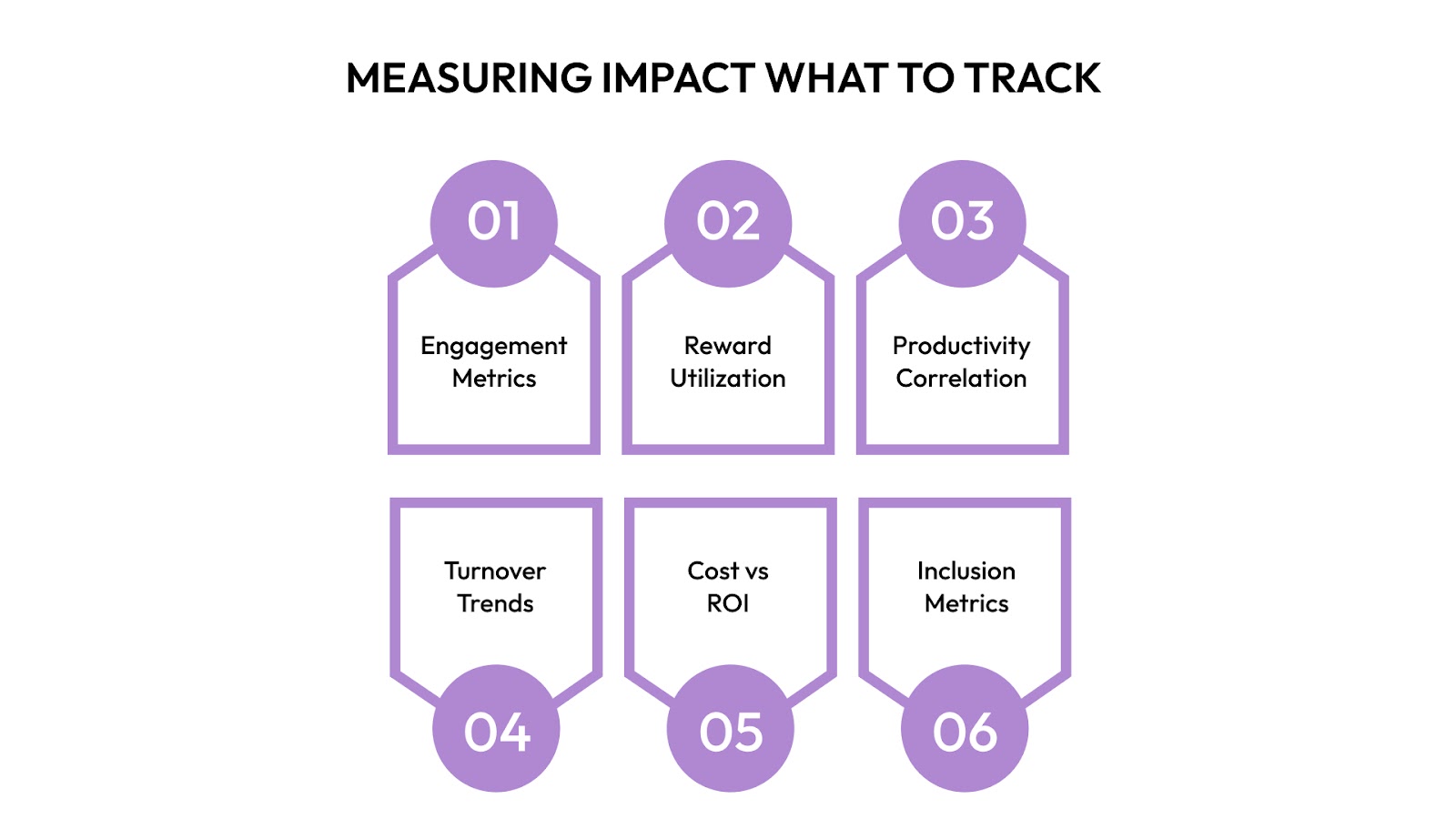
Launching a customized staff rewards strategy is only half the equation. To prove its value and scale what works, you need to track the right metrics. Data-backed evaluation doesn’t just help you measure ROI, it ensures your rewards program drives behavior that aligns with your business goals.
Here’s what you should monitor to ensure your strategy delivers measurable impact.
1. Employee Engagement Metrics
Rewards are ultimately a tool to boost engagement. If your strategy is effective, you’ll see a tangible uptick in how employees interact, contribute, and stay connected to your mission.
What to track:
- eNPS (Employee Net Promoter Score): Measures likelihood of employees recommending your company.
- Engagement survey scores: Track changes in responses to questions about recognition, value, and motivation.
- Platform usage rates: If using a recognition platform, monitor login frequency, reward claims, and peer-to-peer nominations.
2. Reward Program Utilization
Adoption is a clear indicator of program health. If participation is low, either the rewards aren’t meaningful or the system isn’t accessible.
What to track:
- Redemption rates: Are employees using the rewards offered?
- Distribution frequency: How often are rewards being given—and by whom?
- Department-level participation: Identify engagement gaps across teams or functions.
Low manager participation is often a leading indicator of cultural misalignment or lack of enablement.
3. Performance and Productivity Correlation
Your reward strategy should reinforce high performance, not just celebrate tenure or presence.
What to track:
- Goal attainment post-recognition: Are recognized employees achieving more?
- Manager feedback trends: Gather qualitative data on whether rewards improve motivation and focus.
- Recognition vs. performance ratings: Look for alignment between top performers and top reward recipients.
4. Retention and Turnover Trends
Recognition has a direct impact on employee stickiness. If rewards are well-aligned, you’ll retain more high performers and reduce regrettable attrition.
What to track:
- Attrition rates pre- and post-implementation: Focus on high-value talent.
- Exit interview data: Analyze if lack of recognition contributed to turnover.
- Retention among rewarded vs. non-rewarded employees: A clear gap here is a sign of effectiveness.
5. Cost vs. ROI
You don’t need a massive budget to make rewards work, but you do need to measure impact versus cost.
What to track:
- Cost per reward issued: Breakdown by type and frequency.
- Value of time saved or productivity gained: Particularly for automated milestones or performance-based rewards.
- Impact on recruitment: Recognition and rewards contribute to employer brand, track offer acceptance rates and candidate feedback.
6. Equity and Inclusion Metrics
A truly strategic customized staff rewards strategy ensures fair recognition across levels, genders, and geographies.
What to track:
- Demographic breakdowns: Ensure rewards aren’t skewed by bias.
- Reward type preferences by segment: Customize offerings based on generational or regional expectations.
- Consistency in reward frequency across managers: Spot favoritism or inconsistent practices early.
Turn Data Into Strategy with CandorIQ
Tracking is only useful if it fuels better decision-making. CandorIQ integrates reward metrics directly with compensation, performance, and planning data, you get:
- Real-time visibility into who’s being rewarded and why
- Intelligent alerts on under-recognized departments or teams
- Strategic dashboards that correlate recognition with attrition, engagement, and compensation shifts
CandorIQ transforms reward tracking from a manual chore into a strategic advantage.
Your rewards program shouldn’t just feel good, it should perform well. By focusing on the right metrics and using tools like CandorIQ to surface insights, you can ensure your customized staff rewards strategy drives lasting value for both employees and your business.

Common Pitfalls to Avoid
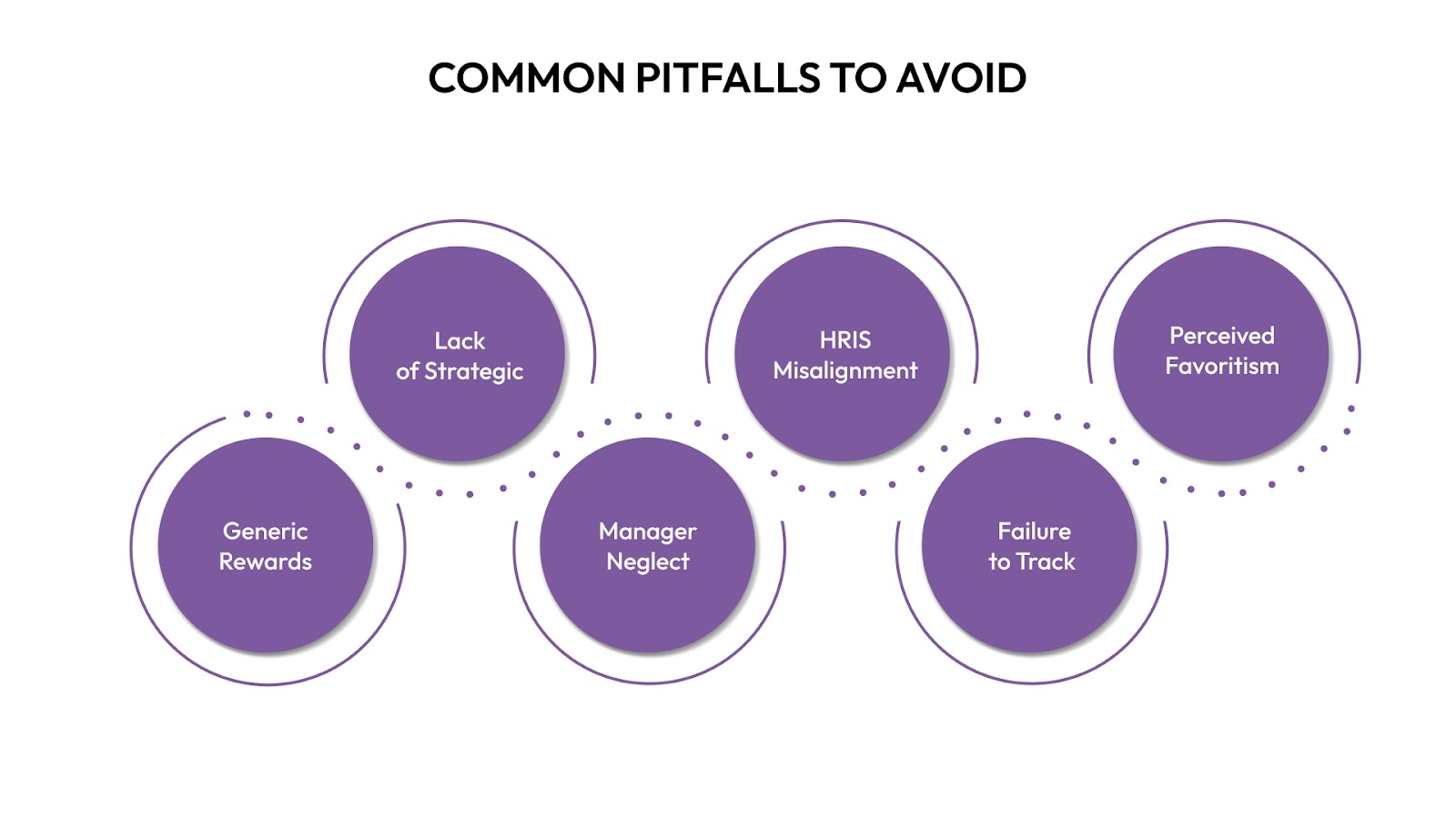
Designing a customized staff rewards strategy requires more than creativity, it demands precision, consistency, and strategic alignment. Even with the best intentions, many organizations fall into traps that reduce program impact, inflate costs, or create unintended consequences.
Here’s a breakdown of the most common pitfalls to watch out for, and how you can avoid them.
1. Over-Reliance on Generic Rewards
What motivates a Gen Z software engineer isn’t the same as what drives a tenured operations manager. Yet, many companies apply uniform reward models across diverse roles, locations, and career stages.
Why it’s a problem:
- Fails to resonate with employees on a personal level
- Leads to low engagement and poor redemption rates
- Wastes budget on rewards that go unused
Solution: Use demographic and performance data to offer personalized, meaningful reward options. Platforms like CandorIQ can integrate these insights directly into your rewards strategy for greater precision.
2. Lack of Strategic Alignment
A reward strategy detached from business goals can feel random, even disruptive.
Where it shows up:
- Recognizing effort over results
- Rewarding low-impact behaviors
- Creating internal confusion around what gets rewarded
Solution: Tie rewards directly to performance KPIs, core values, and company milestones. For example, link recognition to high-impact actions like closing a strategic deal or reducing customer churn.
3. Ignoring Manager Involvement
HR can design the program, but managers own the execution. A disengaged or inconsistent manager population often breaks even the best reward systems.
Symptoms:
- Rewarding only a handful of direct reports
- Forgetting to nominate or approve rewards
- Skipping public recognition moments
Solution: Train managers on how to use your customized staff rewards strategy as a leadership tool. Embed recognition workflows into existing HRIS or CandorIQ dashboards for ease of use and accountability.
4. No Integration with Compensation and HRIS
Without system integration, you risk siloed execution, duplication, or compliance issues.
Consequences:
- Manual data entry across platforms
- Rewarding ineligible employees
- Lack of visibility into total compensation
Solution: Integrate your rewards program with your HRIS and compensation planning tools like CandorIQ. This ensures real-time eligibility checks, equitable recognition, and accurate total rewards visibility.
5. Failure to Track and Iterate
If you’re not measuring the effectiveness of your reward efforts, you’re flying blind.
Warning signs:
- No visibility into who is being recognized and how often
- Rewards go unclaimed or unused
- Leadership questions ROI
Solution: Set clear KPIs, segment by department or role, and review performance quarterly. Platforms like CandorIQ can surface patterns and outliers, helping you refine your reward mix continuously.
6. Inconsistency and Perceived Favoritism
Recognition loses power when it’s sporadic or seen as biased.
Common causes:
- Subjective nominations
- Inconsistent reward criteria
- Lack of documentation or transparency
Solution: Standardize reward criteria and document recognition events. Create visibility through dashboards and cross-functional tracking.
By identifying these roadblocks early and using smart integrations like CandorIQ, you can ensure your customized staff rewards strategy delivers sustainable impact, not just momentary morale boosts.
Whether you're scaling rewards globally or refreshing an outdated system, avoiding these pitfalls sets the foundation for a recognition culture that actually moves the needle on engagement, performance, and retention.
How CandorIQ Powers a Smarter Reward Strategy

If you’re serious about building a customized staff rewards strategy that aligns with performance, drives motivation, and scales with your business, CandorIQ gives you the intelligence, automation, and integration to make it happen.
Rather than treating rewards as isolated perks, CandorIQ integrates reward logic into your broader HR and finance ecosystem, providing full visibility and alignment with organizational goals.
1. Align Rewards With Real-Time Compensation Data
One of the biggest challenges in reward programs is balancing recognition with fairness and pay equity. With CandorIQ, you gain real-time visibility into employee compensation bands, equity grants, and total rewards, ensuring reward decisions are informed, consistent, and aligned with organizational norms.
Key Benefits:
- Prevent over-rewarding high earners while overlooking others in similar roles
- Highlight recognition gaps across gender, department, or tenure
- Set automated eligibility rules based on comp data to avoid manual guesswork
2. Automate Reward Triggers Based on Performance and Milestones
Manually tracking recognition opportunities leads to missed moments. CandorIQ connects with your performance management tools to automatically surface reward triggers like:
- Project completions
- Promotion milestones
- Exceeding KPIs
- Peer-nominated recognition
This means your managers receive nudges when it's time to reward, and employees are recognized in the moments that matter most.
3. Customize Reward Logic by Department, Region, or Role
Motivation isn’t uniform and neither should your reward model be. CandorIQ enables tailored reward structures across business units:
- Sales teams: Tie rewards to revenue milestones or quota overachievement
- Engineering: Recognize innovation, code quality, or system uptime
- Support or Ops: Reward first-response times, resolution rates, or CSAT improvements
You can also adjust rewards by location to reflect cost of living, taxation, and local preferences.
4. Connect Rewards With Headcount and Budget Planning
A common failure point in reward strategies is budget misalignment. CandorIQ brings Finance into the process by integrating rewards into workforce and headcount planning workflows.
What you can do:
- Set departmental reward budgets by headcount or FTE allocation
- Model reward spend impact on operating margin or forecast
- Route approvals through finance or HRBP workflows automatically
This reduces overages and aligns HR motivation programs with broader fiscal discipline.
5. Provide Transparent Reporting and Audit Trails
C-level leaders want proof of impact. CandorIQ delivers dashboards that show:
- Who’s being rewarded
- Why and when they were rewarded
- Which departments or managers are lagging
- How rewards correlate with performance and retention
This data becomes a powerful tool for DEI, compliance, and cultural initiatives, and makes HR a strategic advisor, not just a service function.
6. Integrate Seamlessly With HRIS and Performance Tools
Reward strategies shouldn’t live in isolation. With CandorIQ, you can plug into your existing tech stack:
- HRIS platforms: For real-time employee and org data
- Payroll tools: For taxable reward disbursement and tracking
- Performance platforms: To trigger recognition based on OKRs, feedback, or review cycles
- AI-powered chatbots: To allow employees to view rewards, nominate peers, or check eligibility directly in chat
With CandorIQ, you can finally connect the dots between compensation, recognition, and business outcomes. Instead of launching a reward program and hoping it works, you’ll operate with real-time intelligence, automation, and governance, ensuring your customized staff rewards strategy is as agile and data-informed as the rest of your organization.
Ready to power a smarter, fairer, and more strategic reward system? Book a demo and start rewarding with confidence.

Conclusion
Building a customized staff rewards strategy is about more than perks, it is aligning recognition with individual performance, role expectations, and organizational goals.
When executed right, tailored rewards enhance engagement, improve equity, and drive results that matter across departments and leadership levels. But to make it scalable and sustainable, you need data-driven tools and intelligent workflows.
From integrating compensation data to automating reward triggers and providing full visibility across your workforce, CandorIQ turns recognition into a strategic lever, not just a feel-good gesture.
Don’t just reward employees, motivate them with purpose. Book a demo with CandorIQ today to power your next-generation rewards strategy.


